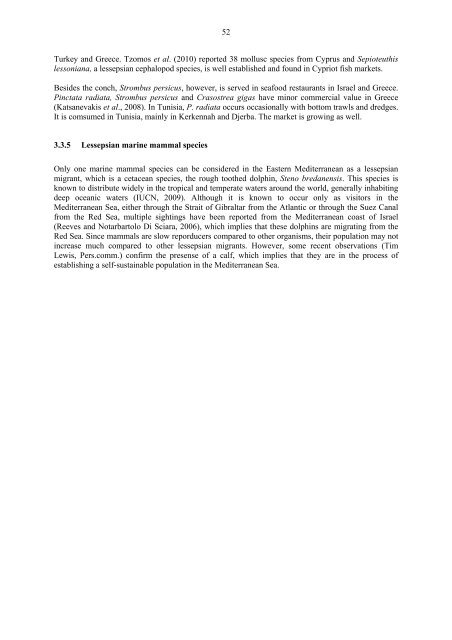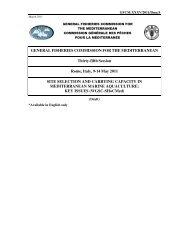Status of alien species in the Mediterranean and Black Sea
Status of alien species in the Mediterranean and Black Sea
Status of alien species in the Mediterranean and Black Sea
Create successful ePaper yourself
Turn your PDF publications into a flip-book with our unique Google optimized e-Paper software.
52<br />
Turkey <strong>and</strong> Greece. Tzomos et al. (2010) reported 38 mollusc <strong>species</strong> from Cyprus <strong>and</strong> Sepioteuthis<br />
lessoniana, a lessepsian cephalopod <strong>species</strong>, is well established <strong>and</strong> found <strong>in</strong> Cypriot fish markets.<br />
Besides <strong>the</strong> conch, Strombus persicus, however, is served <strong>in</strong> seafood restaurants <strong>in</strong> Israel <strong>and</strong> Greece.<br />
P<strong>in</strong>ctata radiata, Strombus persicus <strong>and</strong> Crasostrea gigas have m<strong>in</strong>or commercial value <strong>in</strong> Greece<br />
(Katsanevakis et al., 2008). In Tunisia, P. radiata occurs occasionally with bottom trawls <strong>and</strong> dredges.<br />
It is comsumed <strong>in</strong> Tunisia, ma<strong>in</strong>ly <strong>in</strong> Kerkennah <strong>and</strong> Djerba. The market is grow<strong>in</strong>g as well.<br />
3.3.5 Lessepsian mar<strong>in</strong>e mammal <strong>species</strong><br />
Only one mar<strong>in</strong>e mammal <strong>species</strong> can be considered <strong>in</strong> <strong>the</strong> Eastern <strong>Mediterranean</strong> as a lessepsian<br />
migrant, which is a cetacean <strong>species</strong>, <strong>the</strong> rough too<strong>the</strong>d dolph<strong>in</strong>, Steno bredanensis. This <strong>species</strong> is<br />
known to distribute widely <strong>in</strong> <strong>the</strong> tropical <strong>and</strong> temperate waters around <strong>the</strong> world, generally <strong>in</strong>habit<strong>in</strong>g<br />
deep oceanic waters (IUCN, 2009). Although it is known to occur only as visitors <strong>in</strong> <strong>the</strong><br />
<strong>Mediterranean</strong> <strong>Sea</strong>, ei<strong>the</strong>r through <strong>the</strong> Strait <strong>of</strong> Gibraltar from <strong>the</strong> Atlantic or through <strong>the</strong> Suez Canal<br />
from <strong>the</strong> Red <strong>Sea</strong>, multiple sight<strong>in</strong>gs have been reported from <strong>the</strong> <strong>Mediterranean</strong> coast <strong>of</strong> Israel<br />
(Reeves <strong>and</strong> Notarbartolo Di Sciara, 2006), which implies that <strong>the</strong>se dolph<strong>in</strong>s are migrat<strong>in</strong>g from <strong>the</strong><br />
Red <strong>Sea</strong>. S<strong>in</strong>ce mammals are slow reporducers compared to o<strong>the</strong>r organisms, <strong>the</strong>ir population may not<br />
<strong>in</strong>crease much compared to o<strong>the</strong>r lessepsian migrants. However, some recent observations (Tim<br />
Lewis, Pers.comm.) confirm <strong>the</strong> presense <strong>of</strong> a calf, which implies that <strong>the</strong>y are <strong>in</strong> <strong>the</strong> process <strong>of</strong><br />
establish<strong>in</strong>g a self-susta<strong>in</strong>able population <strong>in</strong> <strong>the</strong> <strong>Mediterranean</strong> <strong>Sea</strong>.
















